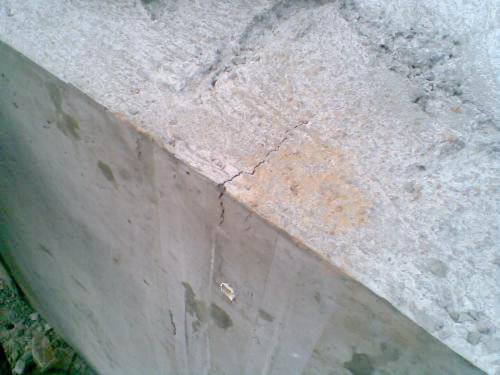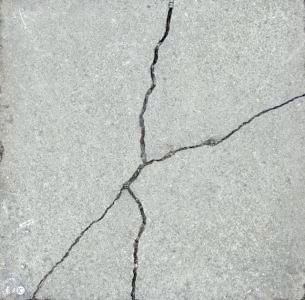Several common cracks in concrete engineering and preventive measures
Concrete is a kind of heterogeneous brittle material, which is composed of sand aggregate, cement, water and other additional materials. Due to a series of problems such as concrete construction, deformation and restraint, there are many micropores, cavitation and microcracks in hardened concrete. It will reduce the durability of the reinforced concrete and the durability of the reinforced concrete. There are many reasons for concrete cracks, such as temperature change, shrinkage, expansion, uneven settlement and other reasons, cracks caused by external load, cracks caused by improper maintenance and chemical action. The cracks caused by different reasons should be treated differently in actual operation, and the problems should be solved according to the actual situation.

The following are several common cracks in concrete engineering and preventive measures
Dry shrinkage crack and its prevention
Dry shrinkage cracks often occur in a period of time after the completion of concrete curing or a week after the completion of concrete pouring. The evaporation of water in cement slurry will cause drying shrinkage, and this shrinkage is irreversible. The drying shrinkage cracks are also different due to the different degree of water evaporation inside and outside the concrete: under the influence of external conditions, the surface moisture loss is too fast, the deformation is large, the change of internal humidity is small, and the large surface dry shrinkage deformation is constrained, resulting in large tensile stress and cracks. The lower the relative humidity is, the greater the dry shrinkage of cement paste is, and the more prone to dry shrinkage cracks. Most of the dry shrinkage cracks are surface parallel linear or reticular shallow and fine cracks, with the width of 0.05 mm ~ 0.2 mm. The plane parts of mass concrete are common, and the thin beams and slabs are mostly distributed along its short direction. Dry shrinkage cracks usually affect the impermeability of concrete, cause corrosion of reinforcement, and affect the durability of concrete. Under the action of water pressure, it will produce hydraulic splitting phenomenon and affect the bearing capacity of concrete. The dry shrinkage of concrete is mainly related to the water cement ratio of concrete, the composition of cement, the amount of cement, the properties and dosage of aggregate and the dosage of admixtures.
Main preventive measures: first, select the cement with small shrinkage, generally use medium low heat cement and fly ash cement to reduce the amount of cement. Second, the dry shrinkage of concrete is greatly affected by the water cement ratio. The larger the water cement ratio is, the greater the dry shrinkage is. Therefore, in the design of concrete mix proportion, the selection of water cement ratio should be controlled as much as possible, and appropriate water reducing agent should be added. The third is to strictly control the mix proportion in concrete mixing and construction. The water consumption of concrete must not be greater than the water consumption given in the mix proportion design. If necessary, qualified technicians should be invited to carry out site mixing. The fourth is to strengthen the early curing of concrete, and appropriately extend the curing time of concrete. In winter construction, it is necessary to extend the covering time of concrete insulation and brush curing agent. The fifth is to set up appropriate contraction joint in concrete structure. Sixth, additives with good water retention property are added to concrete. Now the best water retention additive for concrete is HPMC. Different types of HPMC are selected according to different needs. It is suggested to select professional HPMC enterprises with large brands. The quality of HPMC is guaranteed and the amount of additives can be referred to.
Plastic shrinkage crack and its prevention
Plastic shrinkage refers to the shrinkage of concrete surface due to rapid water loss before setting. Plastic shrinkage cracks usually appear in dry hot or windy weather. The cracks are usually wide in the middle, thin at both ends and inconsistent in length. The main reasons are as follows: the concrete has little strength or little strength before the final setting, or the strength of the concrete is very small just after the final setting. Due to the influence of high temperature or strong wind, the water loss on the surface of concrete is too fast, resulting in a large negative pressure in the capillary tube, which makes the volume of concrete shrink rapidly. At this time, the strength of concrete can not resist its own shrinkage, so it is produced Cracking. The main factors affecting the plastic shrinkage cracking of concrete are water cement ratio, setting time of concrete, environmental temperature, wind speed and relative humidity.
The main preventive measures are as follows: first, select Portland or ordinary portland cement with small dry shrinkage value and high early strength. The other is to strictly control the water cement ratio and add superplasticizer to increase the slump and workability of concrete and reduce the amount of cement and water. Third, before pouring concrete, the base course and formwork shall be watered until they are completely wet. Fourth, timely cover with plastic film or wet straw mat, hemp, etc., to keep the surface of concrete wet before final setting, or spray curing agent on the surface of concrete for curing. Fifthly, sunshade and wind proof facilities should be set up in case of high temperature and strong wind, and timely maintenance should be carried out. The seventh is to add water retaining material hydroxypropyl methyl cellulose, crack resistant material polypropylene short cellulose and redispersible latex powder. This can significantly improve the quality of concrete, simple to solve the above problems.

Settlement crack and Prevention
The settlement cracks are caused by the uneven soil quality of the structure foundation, the unfitness of the backfill, or the uneven settlement caused by water immersion. Sometimes it is formed because of the insufficient rigidity of the formwork, the large spacing of the formwork support, or the looseness of the support bottom, especially in winter, when the formwork is supported on the frozen soil, the uneven settlement occurs after the frozen soil thaws, resulting in cracks in the concrete structure. This kind of fracture is mostly deep or penetrating, and its strike is related to the subsidence, and generally develops along the direction perpendicular to the ground or along the angle of 30 to 45 degrees. The larger subsidence cracks often have some dislocation, and the crack width is often proportional to the settlement. The crack width is less affected by temperature change. After the foundation deformation is stable, the settlement cracks tend to be stable.
Main preventive measures: first, the soft soil and fill foundation should be tamped and reinforced before the superstructure construction. The second is to ensure that the formwork has sufficient strength and rigidity, and the support is firm, and the foundation is stressed evenly. The third is to prevent the foundation from being soaked by water in the process of concrete pouring. Fourth, the time of formwork removal should not be too early, and attention should be paid to the order of formwork removal. Fifthly, some preventive measures should be taken when erecting formwork on frozen soil. The sixth is to add early strength materials to advance the strength of concrete, such as adding early strength agent calcium formate or redispersible latex powder, which has achieved the effect of early strength.
Temperature crack and Prevention
Temperature cracks often occur on the surface of mass concrete or in concrete structures with large temperature difference. After concrete pouring, a large amount of hydration heat is produced during the hardening process of cement hydration. Due to the large volume of concrete, a large amount of hydration heat accumulates in the concrete and is not easy to disperse, which leads to the sharp rise of internal temperature, and the rapid heat dissipation of concrete surface, thus forming a large temperature difference between inside and outside. The large temperature difference causes different degrees of thermal expansion and cold contraction between the internal and external parts, resulting in certain tensile stress on the concrete surface. When the tensile stress exceeds the tensile strength of concrete, cracks will appear on the surface of concrete, which often occurs in the middle and late stages of concrete construction. The concrete cracks usually occur in the shallow concrete surface when the temperature difference is relatively large.
The trend of temperature cracks is usually irregular, and large-scale structural cracks are often crisscross. The cracks are parallel to the short side in the structure with large beam and slab length. The deep and penetrating temperature cracks are generally parallel or nearly parallel to the short force direction. The cracks appear in sections along the long side and are dense in the middle. The crack width is different, which is affected by temperature change obviously. It is wider in winter and narrower in summer. The temperature cracks of concrete caused by high temperature expansion are usually thick in the middle and fine at both ends, but the thickness change of cold shrinkage cracks is not obvious. The appearance of this kind of crack will cause the corrosion of steel bar and the carbonization of concrete, and reduce the frost thaw resistance, fatigue resistance and impermeability of concrete.

Main preventive measures: first, try to choose low heat or medium heat cement, such as slag cement, fly ash cement, etc. Second, reduce the amount of cement. The third is to reduce the water cement ratio. The fourth is to improve the aggregate gradation and add fly ash or superplasticizer to reduce the amount of cement and reduce the heat of hydration. The fifth is to improve the mixing process of concrete. On the basis of the traditional three cooling technology, a new secondary air cooling process is adopted to reduce the pouring temperature of concrete. The sixth is to add a certain amount of admixtures with water reducing, plasticizing and retarding effects into the concrete to improve the fluidity and water retention of concrete mixture, reduce the heat of hydration and delay the occurrence time of heat peak. Seventh, in high temperature season, auxiliary measures such as setting up sunshade can be adopted to reduce the temperature of pouring concrete. Eighth, the temperature stress of mass concrete is related to the structure size. The larger the concrete structure size is, the greater the temperature stress is. Therefore, it is necessary to reasonably arrange the construction process and pour in layers and blocks to facilitate heat dissipation. The ninth is to set up cooling pipes inside the mass concrete to cool with cold water or air, so as to reduce the temperature difference between inside and outside the concrete. Ten is to strengthen the monitoring of concrete temperature and take timely cooling and protection measures. Eleven is to reserve temperature contraction joint. 12. Before pouring concrete, it is advisable to lay about 5mm sand cushion on bedrock and old concrete or brush with asphalt and other materials. The thirteenth is to strengthen the concrete maintenance. After the concrete is poured, it should be covered with wet straw curtain and hemp pieces in time, and attention should be paid to the watering maintenance. The curing time should be appropriately extended to ensure the slow cooling of the concrete surface. In the cold season, the concrete surface should be provided with thermal insulation measures to prevent cold wave attack. The fourteenth is that a small amount of steel bars or fiber materials are added to the concrete to control the temperature cracks within a certain range. The main additives of concrete are: hydroxypropyl methyl cellulose, water reducer, redispersible latex powder, early strength agent, retarder, anti cracking fiber, etc. adding appropriate additives can solve the problems of concrete most effectively.
{aspcms:comment}





